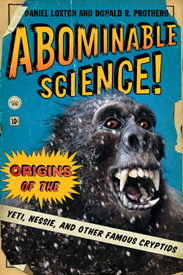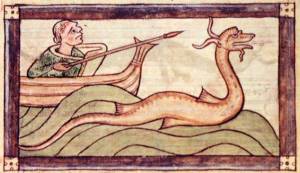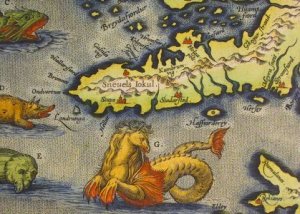 Daniel Loxton and Donald Prothero’s Abominable Science! Origins of the Yeti, Nessie, and Other Famous Cryptids is an admirable book. I admire it immensely. I have used it in my freshman writing classes. If you haven’t bought it already, I encourage you to do so immediately.
Daniel Loxton and Donald Prothero’s Abominable Science! Origins of the Yeti, Nessie, and Other Famous Cryptids is an admirable book. I admire it immensely. I have used it in my freshman writing classes. If you haven’t bought it already, I encourage you to do so immediately.
However, I have some reservations about Loxton’s chapter on Sea Serpents. In chapter 5, “The Evolution of the Sea Serpent: From Hippocamp to Cadborosaurus,” Loxton argues that the classical hippocampus, hippocamp, or hydrippus is behind legends of sea serpents. The hippocamp is a sea monster that is part horse and part fish (or vaguely fish-like).

“Roman Baths, Bath – Sea Horse Mosaic“. Licensed under CC BY-SA 2.0 via Wikimedia Commons.
According to Loxton,
Developed by the Greeks, embraced by the Romans, and passed from country to country during the Middle Ages, the image of the hippocamp slowly mutated into something more than a decoration for vases. Over time, this fantasy creature became an allegedly real crytpid. In my opinion, the modern myth of the Great Sea Serpent (including the recent version, Cadborosaurus) is a cultural invention descended from the artistic tradition of the hippocamp (Abominable Science! 187-88)
Loxton says that hippocamps “were not gods. They were not characters in myths. Most important, they were not believed to be real animals” (AS 188). At least not originally. The image of the hippocamp spread throughout the Roman Empire. The image above comes from a mosaic in Bath, England. The hippocamp also appeared in the Physiologus, a didactic text written in the second century that allegorized animals (real and mythological), plants, and stones.The Physiologus was copied, adapted, and translated over and over again. The oldest vernacular version is in Old English. This verse version from the Exeter Book describes only three animals: the panther, the whale, and the partridge.
The Physiologus also influenced medieval bestiaries, lavishly illustrated compendia of mammals, fish, birds, and serpents, both real and imaginary. Many of these also include hippocamps. However, they also include a wide variety of serpents, including dragons. Some of these, such as the critter identified as a hydrus below, resemble sea serpents.

London, BL MS Harley 3244, fol. 62r. From http://bestiary.ca/manuscripts/manugallery1020.htm#
In a section subtitled “The Hippocamp in Nordic Culture,” Loxton says that the “modern sea serpent legend was born out of Nordic culture, with its origin in medieval Iceland and its florescence in Enlightenment Norway.” It is with this section that I have serious quibbles.
Loxton begins by discussing “The Icelandic Hrosshvalr.” In this section, only one work–a 2009 stamp–is actually Icelandic. The other works discussed are Norwegian or Dutch. Loxton says that
By the twelfth century, the Norse society of Iceland had adopted a belief in a creature called the hrosshvalr (horse whale), which was depicted as an unmistakable hippocamp. We will see that this innovation–the Nordic reimagining of the Greek hippocamp as a maned, horse-headed “real” marine monster–is a key to solving the modern mystery of the Great Sea Serpent. (AS 193).
Despite its name, the hrosshvalr is not “an unmistakable hippocamp.” Loxton admits that it is “probable that the words hrosshvalr (horse + whale) and ‘walrus’ (whale + horse) are etymologically related,” but does not accept that the word generally describes a walrus. Geir Zoëga’s A Concise Dictionary of Old Icelandic defines hrosshvalr as “walrus.” Richard Cleasby and Guðbrandur Vigfússon’s more thorough An Icelandic-English Dictionary also defines it as “walrus” and mentions its etymological relationship to Old English horshwæl (horse-whale), which also means “walrus.”
Loxton then cites the thirteenth-century Norwegian text Konungs skuggsjá (King’s Mirror). In a section on sea creatures (including the sperm whale, narwhal, and Greenland or basking shark), the anonymous author mentions two ferocious critters, the hrosshvalr and the rauðkembingr (red comb, which Cleasby-Vigfússon describe as “a fabulous whale or sea monster”):
There are certain varieties that are fierce and savage towards men and are constantly seeking to destroy them at every chance…. They are very voracious and malicious and never grow tired of slaying men. They roam about in all the seas looking for ships, and when they find one they leap up, for in that way they are able to sink and destroy it the more quickly . These fishes are unfit for human food; being the natural enemies of mankind, they are, in fact, loathsome. (King’s Mirror qtd. in AS 194)
While Loxton notes that scholars “have tended to identify these creatures as walruses or sea lions” (194), he points out that, according to the description, they are much too large (thirty or forty ells–67 to 90 feet). While the description does not fit real pinnipeds, there’s nothing particularly horsey about the description either, except for the element hross in the animal’s name. And, since we know the word hrosshvalr could mean “walrus,” we can’t leap to the conclusion that it refers here to the hippocamp just because the first element in both compounds means “horse.” The creature’s size could be an exaggeration, along with its willful enmity toward humans.
A stronger link between the hrosshvalr and the hippocamp comes from Abraham Ortelius’s map of Iceland.
The sea surrounding Iceland is positively teeming with monsters. Just below Snæfelsness is a very horsey looking hrosshvalr.
The problem is that Ortelius was a Flemish cartographer working in the late sixteenth century. He is not a medieval Icelander depicting a native beastie; he is a Renaissance artist representing another culture’s folkloric monster. He has made the Icelandic hrosshvalr into a classical hippocamp. Renaissance artists classicized everything. Loxton fails to provide convincing evidence that medieval Scandinavians interpreted or depicted the hrosshvalr as “an unmistakable hippocamp.” This is problematic as this association is crucial to his argument. For instance, in his discussion of Olaus Magnus’s A Description of the Northern Peoples (1555), he says the book “provided the final stage set for the modern sea serpent (although the curtain would not fully open for a further 200 years). By then, the Scandinavian reimagining of the Greek hippocamp as a ‘real’ sea monster was itself a centuries-old tradition,” but the evidence for this centuries-old tradition is extremely weak.
In the next section, Loxton discusses Jörmungandr or Midgarðsormr, the World Serpent, a mythological Norse sea serpent that in no way resembles a hippocamp. An offspring of Loki and the giantess Angrboða, the World Serpent lies in the ocean and encircles the earth.
Loxton admits that “[i]t is certainly plausible, even likely, that the Jörmungandr myth could be among the roots of the Norwegian sea serpent legend. In turn, the Midgard Serpent can be plausibly interpreted as a regional iteration of primordial dragon myths, such as the Babylonian Tiamat and the biblical Leviathan” (197), but he minimizes its importance, mentioning it only briefly before returning to the hippocamp.
He also makes a strange statement about the World Serpent:
It’s worth noting that our sources for the Midgard Serpent and other Norse myths date from well into the Christianization of the Nordic countries. Written by a Christian, The Prose Edda begins with the words, “In the beginning God created heaven and earth and all those things which are in them; and last of all, two of human kind, Adam and Eve, from whom the races are descended” (197)
I’m not sure why it is important to note this. Is the Prose Edda’s description of the World Serpent untrustworthy because it has been tainted by Christianity? Even if this were the case, how is that different from the alleged influence of the classical hippocamp on the native hrosshvalr?
In any case, the statement is incomplete to the point of inaccuracy. It’s true that Snorri Sturluson, the author of the Prose Edda, was a Christian. It is also true that he began his work with a concise summary of Genesis and that he euhemerized Norse mythology as part of the framework of the Edda; however, once he began recounting the mythological stories, he just got on with the job, without constantly moralizing and euhemerizing (unlike Saxo Grammaticus, another major source for Norse mythology).
It is also true that Snorri may have misunderstood some elements of the mythology he was recounting; he certainly conflated and interpreted the material he gathered from his various sources. Consequently, our concepts about Norse mythology may be somewhat skewed and may not match the beliefs and rituals as they were actually practiced by pre-Christian Germanic peoples.
But not the World Serpent. The World Serpent is well attested in works earlier than the Prose Edda. One of the most famous stories about the World Serpent concerns Thor’s attempt to catch it during a fishing expedition. This story is told in Hymiskviða from the Poetic Edda. The exact age of the poems in the Poetic Edda is a matter of dispute. There are also questions about how much they were altered in transmission, but Thor’s fishing expedition is mentioned in earlier skaldic poems, such as Bragi Boddason’s Ragnarsdrápa (ninth century) and Úlfr Uggason’s Húsdrápa (tenth century). Both these poems were composed before the conversion to Christianity. Of course, they are preserved in later, post-conversion works (Snorri quotes them), but there are also several early carvings which depict the World Serpent and Thor’s fishing expedition.
The World Serpent clearly goes back to pre-conversion Germanic traditions, and it seems to have been the source for some later sea serpent tales, such as that of the Stoorworm.
In the next installment, I will discuss other Germanic sea serpent tales.
ES




[…] Humanities [16:05] – Sea Serpents and the Hippocampus in Abominable Science. – Daniel Loxton and Donald Prothero, Abominable Science! Origins of the Yeti, Nessie, and Other […]
Great post. The question of how Snorri Christian belief’s may have affected how he wrote about is a interesting question but from my reading of Snorri’s Edda I suspect a lot less than you would think. In fact I am impressed by Snorri’s remarkable lack of bias in recording these tales and myths. It is actually quite remarkable, and is a blessed relief from Saxo. The fact Snorri is a much better writer helps of course.
Saxo has that rare talent of taking interesting material and beating it into a dull, boring pablum.
Either the boat has a foot… (advanced feature not available to pre-cyborg sociaties)… Or that dude just steped through a hole.
So…
That’s the punchline to a joke. Something like: Bjorg was sailin’ across the fjord, when… bla bla bla seamonsters chasing something something… And JUST when he thought he was guna get away… KA-THUNK!